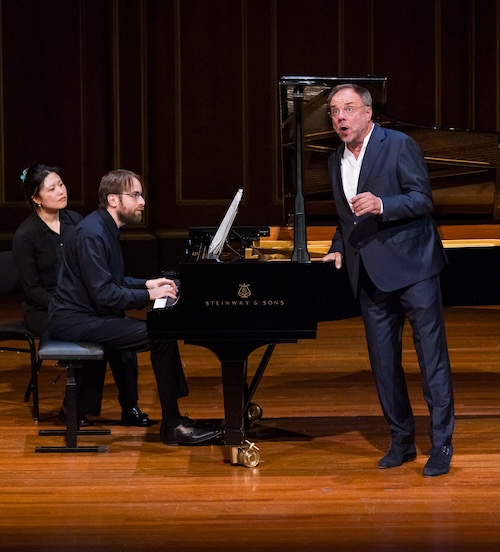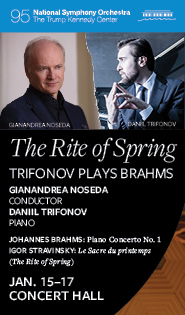Performances
Soprano Forsythe sparks National Symphony’s lean and protean “Messiah”
Reviewing Messiah can feel like a dreaded critical chore every December. […]
Bach Consort’s “Christmas Oratorio” rings in the season in joyous fashion
Dana Marsh conducted Bach’s Christmas Oratorio when he made his first […]
WNO’s “Little Prince” brings seasonal holiday magic for all ages
Francesca Zambello conceived of a family-oriented opera based on Antoine de […]
Grosvenor scales the heights with a trio of blockbusters for Chamber Music Maryland
Chamber Music Maryland brought Benjamin Grosvenor back to the Horowitz Center […]
Shaham helps Wolf Trap celebrate a barn tricentenary with well-balanced program
Three hundred years ago, a German immigrant built a barn for […]
Articles
Patrick Quigley to open new Opera Lafayette era with a fresh look at “Dido and Aeneas”
At the end of Opera Lafayette’s 30th season last May, founder […]
Critic’s Choice
Lawrence Brownlee, Erin Morley, and Gerald Martin Moore. Vocal Arts DC. […]
The Year in Review
Top Ten Performances of 2025
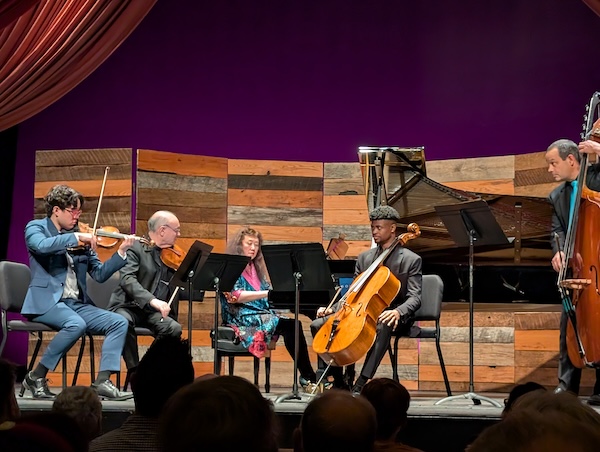
Photo: C. Downey/WCR
Pianist Wu Han ended her superlative tenure as artistic advisor for the chamber music series at Wolf Trap, a position she took up in the 2018-2019 season. Her final concert in March underscored the reasons for regretting her departure: Schubert’s “Trout” Quintet was the culmination of works for various combinations of the same instruments by Wilhelm Friedemann Bach and Mozart. Hopes remain high that her successor, Daniel Hope, will continue the high level of programming she established.
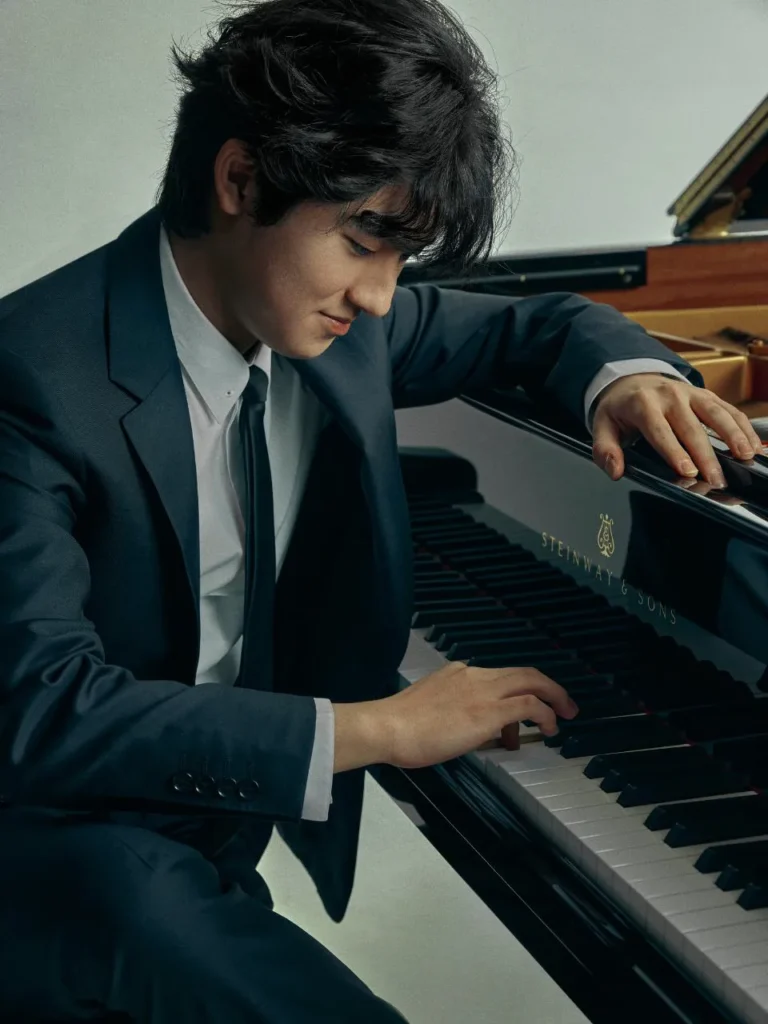
File photo: James Hole
2. Bach: Goldberg Variations. Yunchan Lim. Washington Performing Arts.
This South Korean pianist took the Gold Medal at the 2022 Van Cliburn International Competition, at age 18 the youngest pianist ever to do so. His 2024 debut with the National Symphony Orchestra did not make the cut for last year’s Top Ten, but this belated recital did. This was an old-fashioned, even romantic version of the baroque masterpiece— Bach with a Busoni vibe: added octaves, repeats up an octave, embellishments, and a free sense of rubato.
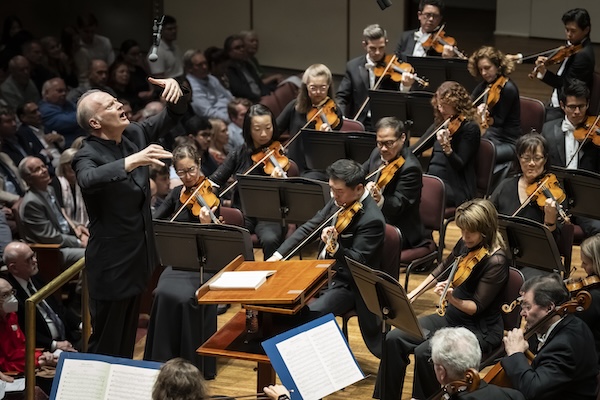
Photo: Scott Suchman
3. Beethoven: Missa Solemnis. Gianandrea Noseda/National Symphony Orchestra.
Last May, Gianandrea Noseda ended his eighth season at the helm of the NSO with a trifecta of monumental works. After acerbic Schnittke and Shostakovich, and Mahler’s violent Sixth Symphony, came a glorious performance of Beethoven’s Missa Solemnis. With a quartet of mostly excellent singers and an expertly drilled Washington Chorus, the score served as a compelling call to peace, a message as important as ever.
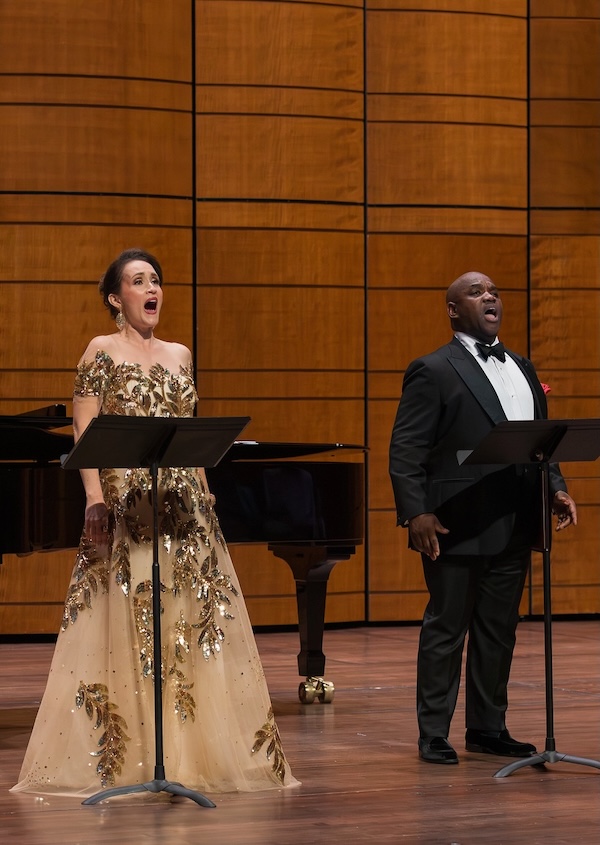
Photo: Caitlin Oldham
4. Opera arias and duets. Erin Morley, Lawrence Brownlee, and Gerald Martin Moore. Vocal Arts DC.
Two giants of the coloratura repertoire, soprano Erin Morley and tenor Lawrence Brownlee, brought their duo recital to the Kennedy Center Terrace Theater in September. Pyrotechnics landed explosively and high notes soared in Verdi’s “Caro nome” and Bellini’s “Nel furor delle tempeste,” but comic duets and more musically introspective numbers proved equally pleasing in this dynamic season opener.
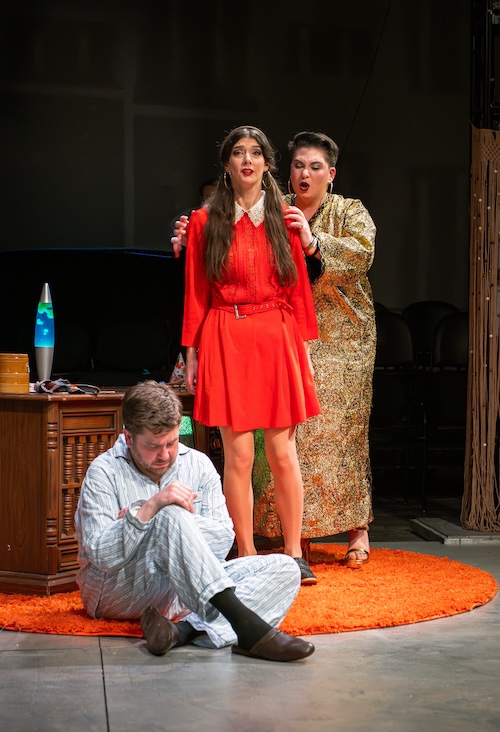
Photo: Bayou Elom
5. Stradella: San Giovanni Battista. IN Series/Catapult Opera.
The chance to hear this gorgeous 17th-century Roman oratorio performed live was already welcome. IN Series upped the ante by staging this innately dramatic work as an opera. Timothy Nelson’s lurid production filled the pop-up black-box venue run by Theater Alliance in Southwest D.C. with garish color, part of the 1970s English adaptation by Bari Biern, mounted in partnership with Catapult Opera. Soprano Dawna Rae Warren excelled in the troubling role of Herodiade the Younger, renamed Salome.
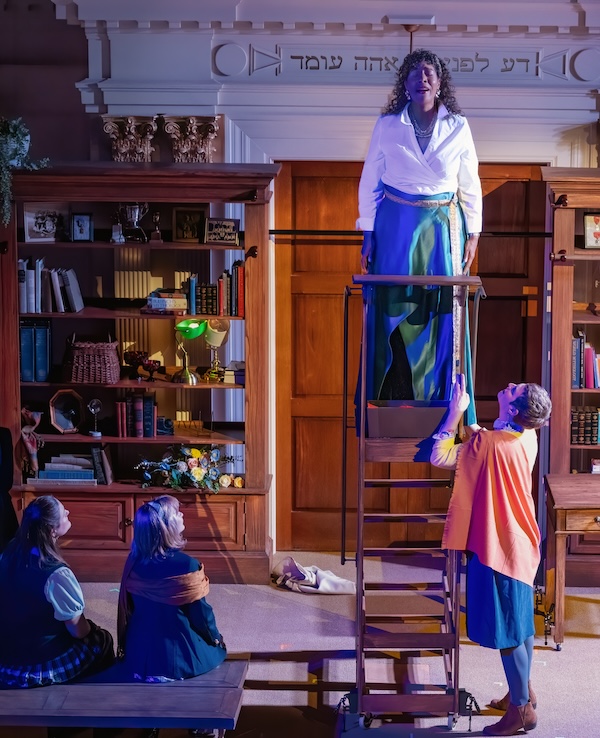
Photo: Jennifer Packard
6. Purcell: Dido and Aeneas. Patrick Quigley/Opera Lafayette.
The season opener for the city’s leading baroque opera company was a night of many firsts. Patrick Quigley, in his first performance as music director, conducted the company’s first staging of Henry Purcell’s greatest work. In the central role of Dido, the potent soprano Mary Elizabeth Williams sang her first-ever baroque role, to noteworthy effect. To get at the heart of the opera’s first performance, by students at Josias Priest’s school for girls in London, Quigley used almost entirely treble voices, with a staging recalling a girls’ boarding school.
7. Schubert: Winterreise. Matthias Goerne and Daniil Trifonov.
The Kennedy Center’s new recital series, dubbed NSO Presents, has yielded some powerful performances, not least this account of Schubert’s dark-hued song cycle. Baritone Matthias Goerne has turned in many fine interpretations of Winterreise, with various pianist partners, but in this version the accompaniment of Daniil Trifonov stood out. The grim bleakness and variety of touch gave each song, each stanza nuance. Rarely has the sentiment of a favorite line, “Wie weit noch bis zur Bahre!” (How much longer to the grave?), rang so bitterly.
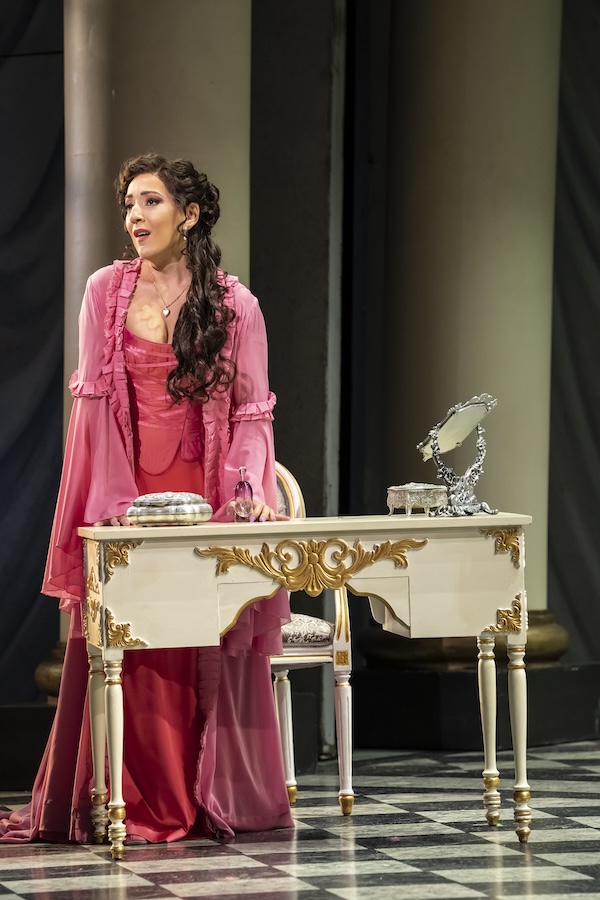
Photo: Scott Suchman
8. Mozart: Le Nozze di Figaro. Washington National Opera.
The Kennedy Center’s resident opera company is having one of its best seasons in recent memory, tragically, just as disaffected subscribers and donors have left in droves. This fall’s revival of arguably Mozart’s greatest opera featured a cast with no real weak links in it. In particular, soprano Rosa Feola’s limpid voice and charming presence made for one of the most ravishing Countesses of my listening life.

Photo: Shawn Miller/LoC
9. Music of Vivaldi. Théotime Langlois de Swarte/Les Arts Florissants. Library of Congress.
The federal government shutdown ended just in time for the latest tour of Les Arts Florissants, the esteemed French early music ensemble, to make a stop there on their latest American tour. This concert celebrated the 300th anniversary of the 1725 publication of Antonio Vivaldi’s Four Seasons, led by violin virtuoso Théotime Langlois de Swarte. The library owns a cherished copy of that first edition, which was on display in the entrance hall before the concert.
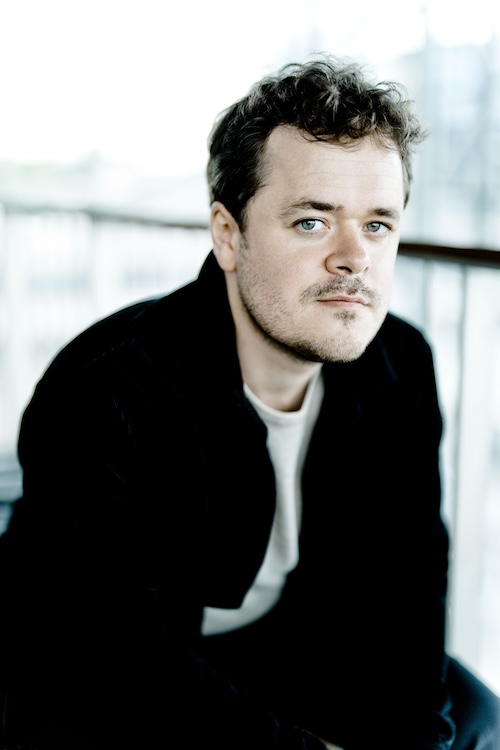
File photo: Marco Borggreve
10. Music of Chopin, Ravel, Mussorgsky. Benjamin Grosvenor. Chamber Music Maryland.
The return of the English pianist came in under the wire to make this year-end roundup. The English pianist performed Chopin’s Piano Sonata No. 2, Ravel’s Gaspard de la nuit, and Mussorgsky’s Pictures at an Exhibition. Any one of these finger-busting works would have sufficed to show impressive technical acumen, let alone all three. Three encores in the same vein capped a roller-coaster of a concert to end the year.
Best New Opera
Of the two new operas Damien Geter premiered locally this year, Loving v. Virginia proved to be one of the most successful new operas of the decade. Jessica Murphy Moo’s libretto centered on the landmark civil rights case, decided unanimously by the Supreme Court in 1967, that struck down Virginia’s state law banning interracial marriage. With a fine production directed by Denyce Graves-Montgomery, this excellent new opera marked Virginia Opera’s golden anniversary season in the best way possible, in a co-commission with the Richmond Symphony,
Best Soloist Visit
Guest conductor Hans Graf presided over the return of Renaud Capuçon to the Kennedy Center Concert Hall. The extraordinary French violinist took the solo part of Alban Berg’s Violin Concerto, at the heart of a program showcasing three musical facets of the city of Vienna. From the distinctive opening of the first movement, a sequence of perfect fifths played on the violin’s open strings, Capuçon brought poetic beauty to this often-astringent score, an instant highlight.
Best Debut
Alexandre Kantorow became the first French pianist to win the Tchaikovsky Competition in 2019. His debut recital, another high point of the NSO Presents series, revealed a musician with an amazing, almost flawless technique, perhaps even exceeded by impeccable musicality. A daunting program combined Liszt’s crazy adaptation of Bach’s Weinen, Klagen, Sorgen, Zagen with piano sonatas by Medtner and Rachmaninoff. In a major flex, Kantorow ended with the arrangement of Bach’s Chaconne in D Minor by Johannes Brahms, for the left hand alone. After that musically expansive rendition, Kantorow offered a single stunning encore, the “Pas de deux” from Tchaikovsky’s The Nutcracker. The virtuosic arrangement was by Mikhail Pletnev, which he first played when he won the Tchaikovsky Competition in 1978.
Best Anniversary
Stile Antico, the exceptional chamber choir specializing in Renaissance music, celebrated their 20th anniversary with an American tour. They made a stop in Georgetown on the Dumbarton Concerts series, which showcased their continued excellence in this repertoire. As an encore, the group honored the 400th anniversary of Orlando Gibbons’ death by singing his madrigal “The Silver Swan.” The piece’s final line (“More geese than swans now live, more fools than wise”) remains an elegant summation of the continuing inadequacy of human insight.
Best Orchestral Programming
Jonathon Heyward, the young music director of the Baltimore Symphony Orchestra, continues to impress with his willingness to feature unusual music. In a concert heard last January, he programmed the Passacaglia from Britten’s Peter Grimes, matched by Lutosławski’s Concerto for Orchestra, which has its own Passacaglia. Conrad Tao, the one-time child prodigy with an actual adult career, played Mozart’s Piano Concerto No. 20, including his own wild, Lisztian cadenzas to scintillating effect. Tao opted for an even more hallucinatory encore in Elliott Carter’s Caténaires, from 2006, written for Pierre-Laurent Aimard as “a fast one-line piece with no chords.”
Most Unusual Act
Chelsea Guo, the winner of the Young Concert Artists 2022 Susan Wadsworth International Auditions, studied both piano and vocal performance during her time at the Juilliard School. For her Kennedy Center debut, presented by Young Concert Artists in the Terrace Theater, she both played and sang, sometimes simultaneously. The dual-duty performance may not be sustainable over a career, but Guo made quite an impression doing both at the same time.
Most Persistent
When Jennifer Koh took up the post of artistic director of the Fortas Chamber Music Concerts series at the Kennedy Center last year, she could not have foreseen the political turmoil that would ensue at the artistic venue by the Potomac. While many of her colleagues there have resigned, Koh has chosen to remain.
The Kennedy Center, and those listeners who are willing to support her in this resolve, are the richer for it. At her season finale last June, the electric pink-haired violinist tackled all of J.S. Bach’s Solo Sonatas and Partitas, an impressive feat of stamina and, above all, musicality.
Sugar Plum Award
Dana Marsh, music director of the Washington Bach Consort, has made a December performance of Bach’s Christmas Oratorio an annual tradition, the German version of a Christmas-tide Messiah. This year’s installment showed that the idea could draw a full house to the large sanctuary of the National Presbyterian Church. With fine solo work from Sylvia Leith, Tyler Duncan, and Hannah De Priest, this performance earned this year’s prize for the year’s best Christmas concert.
Most Dubious Arts Move
In an already tumultuous year for the Kennedy Center, the organization’s governing board made one last obsequious gesture. Earlier this week in a move that surprised no one, the group of loyalists appointed by President Trump voted to rechristen the venue as the Trump-Kennedy Center for the Performing Arts.
Any such name change is likely illegal without an authorizing vote in the U.S. Congress, which established the center as a memorial to President John F. Kennedy after his assassination. Such niceties did not stop the immediate installation of the Trump name on the building’s facade less than 24 hours after the board vote.
The often shocking emptiness of the Concert Hall has demoralized many NSO musicians. This finger-in-the-eye move will only exacerbate the ongoing audience and donor boycott and likely worsen the situation in the new year.
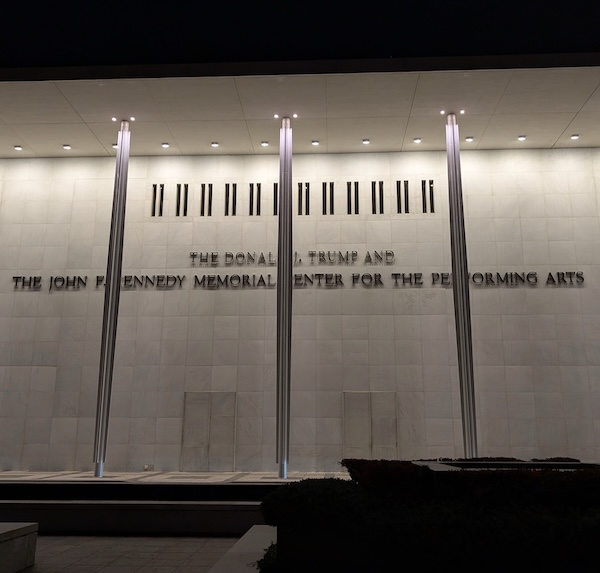
Photo: C. Downey
Lux aeterna luceat eis
This year the classical music world mourned the passing of pianist Alfred Brendel; composers Sofia Gubaidulina, Rodion Shchedrin, and Per Nørgård; conductors Christoph von Dohnányi and Roger Norrington; organist and choirmaster Martin Neary; and bass-baritone Donald McIntyre.
Noteworthy losses in the rest of the arts world included satirical songwriter Tom Lehrer and jazz flugelhornist Chuck Mangione; actors Gene Hackman, Diane Keaton, Val Kilmer, Robert Redford, Terence Stamp, and Claudia Cardinale; visionary film director David Lynch and architect Frank Gehry; authors Mario Vargas Llosa and Edmund White; Pope Francis, scientist Jane Goodall, playwright Tom Stoppard, and stage director Robert Wilson. Among local losses were legendary jazz radio host (and reference specialist at the Library of Congress) Larry Appelbaum; and singer Roberta Flack, who grew up in Arlington, went to Howard, taught in Washington, D.C. schools, and got her big break singing at Mr. Henry’s on Capitol Hill.
Calendar
January 8
BlackBox Ensemble
Cheung: Clocks for Seeing
León: In the […]
News
Washington Classical Review wants you!
Washington Classical Review is looking for concert reviewers in the DC […]
Vienna Philharmonic to visit Kennedy Center
After raising an all-time-record $3.45 million at its first NSO Gala, […]

